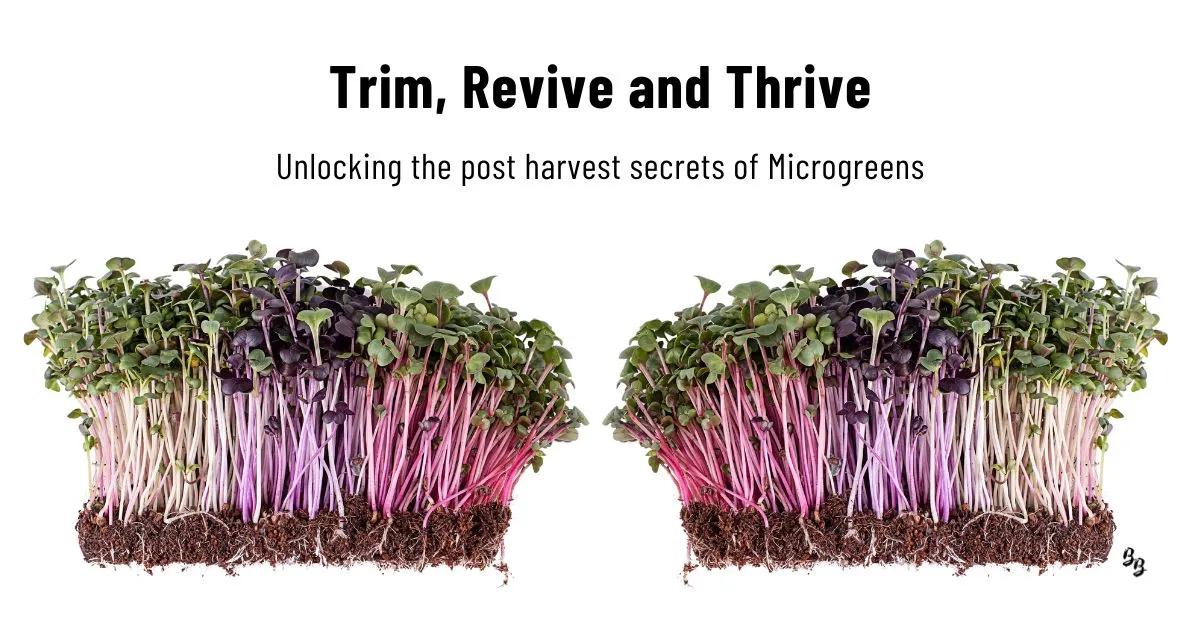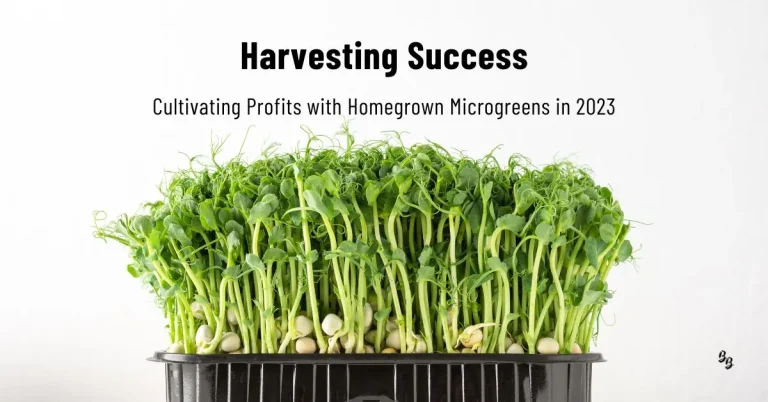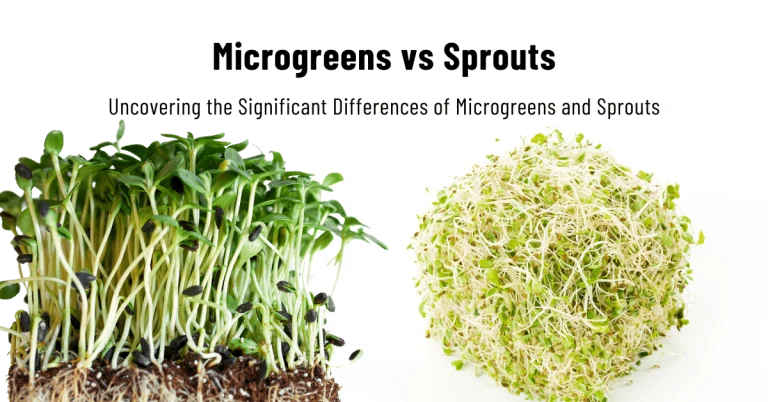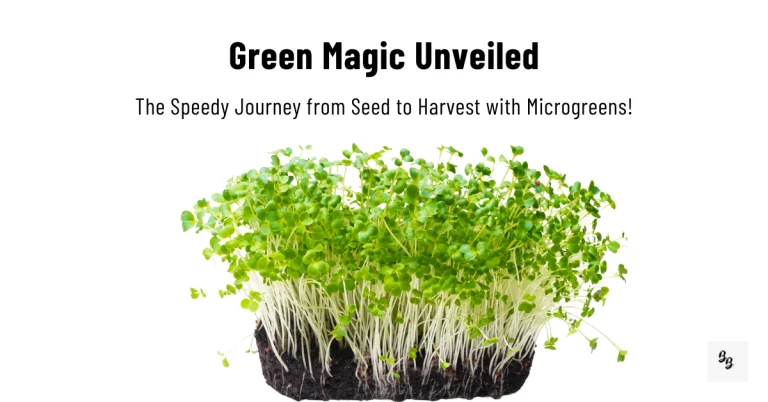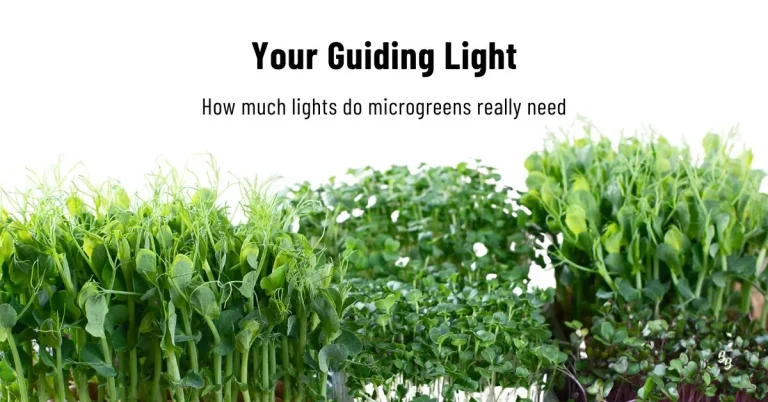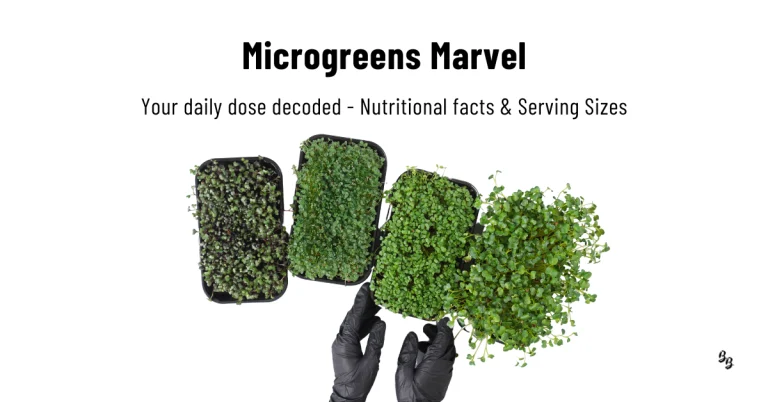Can Microgreens Regrow after cutting (Post Harvest Advice)
Can microgreens regrow after harvesting them? If you’re here, I bet your are wondering what the answer may be to this question. One thing I know, is that it’s a daunting thing to try and regrow microgreens once you harvested the first time.
The short answer: Yes, but we would not recommend microgreens regrowth after harvesting!
Melanie du Plessis
Growing your own microgreens can be a great benefit to your kitchen. These tiny, young greens, harvested at the cotyledon or first true leaf stage of growth, are more than just a garnish – they pack a nutritional punch that belies their size. As they continue to gain popularity, many microgreen growers find themselves wondering about one crucial aspect of their cultivation: Can microgreens regrow after harvesting?
In this blog post, we delve into the fascinating world of microgreens and address the burning question that often lingers in the minds of growers and enthusiasts alike:
Do microgreens possess the ability to regrow after they’ve been harvested?
Understanding the regrowth of microgreens not only plays a pivotal role in optimizing yields for a thriving microgreen business but also contributes to sustainable agricultural practices.
Microgreen varieties play a significant role in determining their regrowth potential. Some varieties exhibit impressive regrowth abilities, while others might offer lower yields after the first harvest.
By comprehending the regrowth patterns of various microgreen types, growers can make informed decisions to maximize overall yield and extend the life cycle of their crops.
During the first harvest, microgreens are usually clipped above the soil line, focusing on the tender and flavorful cotyledons. However, regrowth allows growers to witness the entire plant’s development, with the possibility of harvesting multiple times from a single planting.
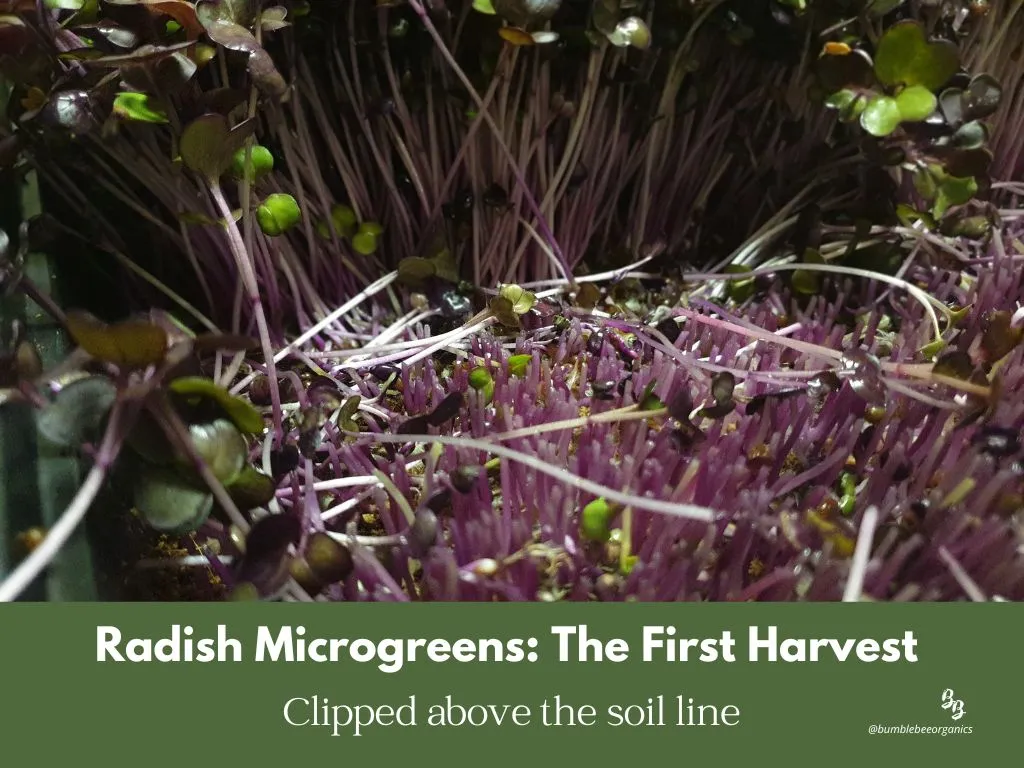
This post-harvest advice will shed light on the regrowth process and provide essential insights into nurturing your microgreens for extended and sustainable cultivation.
So, let’s embark on this green journey together and uncover the wonders of microgreen regrowth! Whether you’re seeking to boost your microgreen yields or simply marvel at the resilience of these young greens, we have valuable insights to share.
Do microgreens regrow after harvest? Why some are not the best option
Most varieties of microgreens don’t fall under the cut-and-come-again vegetable section. Or as others call it the “baby leaf vegetables” or simply “baby greens.”
The term “baby leaf” refers to the practice of harvesting young and tender leaves from a plant, leaving the plant to regrow and produce another flush of fresh leaves.
The cut-and-come-again or baby leaf harvesting method is commonly used for various types of greens, including microgreens and young salad greens. It allows growers to harvest only the outer leaves of the plant, leaving the inner leaves to continue growing. This way, the plant can produce multiple harvests over its growing cycle, providing a continuous supply of fresh and tender greens.
The baby leaf technique is particularly popular for fast-growing leafy vegetables, such as lettuce, spinach, kale, and arugula. It maximizes the yield and ensures a steady stream of fresh produce for consumers. Additionally, baby leaf vegetables are highly sought after in the culinary world due to their delicate texture, intense flavor, and nutritional value.
As Microgreens are densely sown in small containers known as microgreen trays, you can kind of imagen the yield of the regrow once harvested.
Let’s look at some of the microgreen varieties that fall under the cut-and-come-again vegetables and may have chances of regrowth.
Microgreens regrowth: Varieties with Possible Regrowth Capabilities
Microgreens that fall under the “cut-and-come-again” type vegetables are those that possess the ability to regrow after being harvested. As their name suggests, these microgreens can be cut above the soil line during the first harvest, and they will continue to produce new growth, allowing for multiple harvests from the same planting. This regrowth characteristic makes them highly desirable for growers seeking continuous yields and sustainable cultivation.
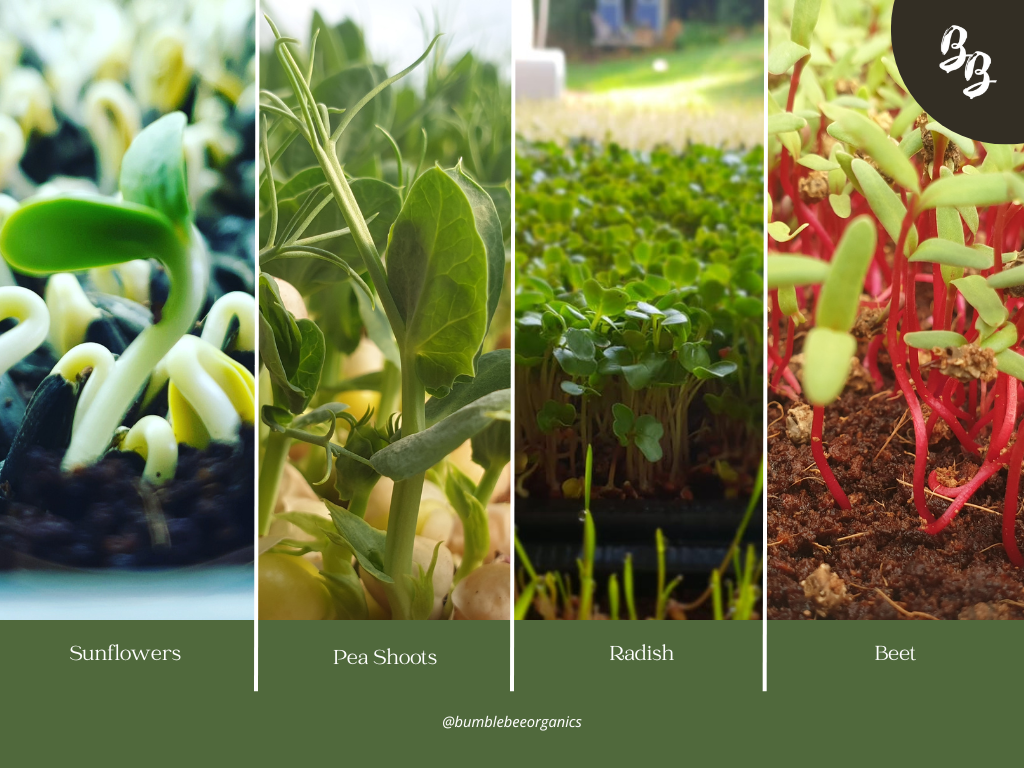
Here are some popular microgreens that belong to the “cut-and-come-again” category:
Pea Shoots (Pisum sativum):
Pea shoots (or green peas) are known for their tender and sweet flavor, reminiscent of fresh peas. These microgreens are excellent candidates for cut-and-come-again harvesting. When properly harvested above the soil line, pea shoots can quickly regrow, providing successive harvests with just a little patience and care.
Sunflower (Helianthus annuus):
Sunflower microgreens are not only visually stunning with their yellow petals and green leaves but also boast a nutty flavor that adds a delightful crunch to salads and sandwiches. Sunflowers are highly prolific, and their cut-and-come-again ability allows for multiple harvests, making them a popular choice among microgreen enthusiasts.
Radish (Raphanus sativus):
Radish microgreens offer a spicy kick that adds zing to various dishes. When harvested above the soil line, radish microgreens often regrow rapidly, presenting opportunities for additional harvests. These greens are not only flavorful but also quick to regenerate, making them an attractive option for growers.
Cilantro (Coriandrum sativum):
Cilantro microgreens feature the distinctive taste of mature cilantro leaves, ideal for enhancing the flavors of Mexican, Indian, and Southeast Asian cuisine. These greens can be harvested multiple times if the stems are left intact during the first cut. With the right care, cilantro microgreens can regrow for extended enjoyment.
Beet (Beta vulgaris):
Beet microgreens boast vibrant red stems and earthy flavors. When harvested properly, beet microgreens can exhibit significant regrowth potential, offering multiple harvests and an extended usage period in the kitchen.
Basil (Ocimum basilicum):
Basil microgreens are adored for their aromatic and herbaceous taste. Though basil typically grows quickly, the cut-and-come-again technique allows growers to enjoy successive harvests of this flavorful green.
Remember that the regrowth potential of microgreens can be influenced by various factors, including variety selection, growing conditions, and proper harvesting techniques. By understanding the cut-and-come-again nature of these microgreens and providing the right care, you can enjoy a continuous supply of fresh and nutritious greens from a single planting.
Factors Affecting Microgreen Regrowth
The regrowth potential of microgreens is influenced by various factors that growers need to consider to maximize yields and ensure a continuous supply of fresh greens. Understanding these factors is crucial for nurturing healthy, resilient microgreens that can thrive and regrow after harvesting. Let’s delve into the key elements that play a significant role in determining whether microgreens can regrow or not:
The Type of Microgreen for regrowth: Some Varieties Have a Higher Regrowth Potential Than Others
Microgreens encompass a wide variety of plant species, each with its unique characteristics and growth patterns. Some microgreen varieties are more adept at regrowing after harvesting, while others may have limited regrowth potential. As mentioned earlier, microgreens like pea shoots, sunflowers, radishes, and beets are known for their impressive regrowth capabilities. On the other hand, certain varieties may produce lower yields after the initial harvest. When planning your microgreen cultivation, research the regrowth characteristics of different varieties and choose those that align with your goals for continuous production.
Cutting Height for regrowth purposes: How Low You Cut the Microgreens During Harvesting Affects Their Ability to Regrow
The height at which you harvest microgreens can significantly impact their regrowth potential. When harvesting microgreens for the first time, it is essential to cut above the soil line, leaving a portion of the stem intact. Cutting too close to the growing medium can damage the growth point of the plant, hindering its ability to regrow. Leaving a sufficient length of stem allows the microgreens to recover and generate new growth. Proper cutting techniques are crucial for encouraging the regrowth of your microgreens and ensuring a healthy, continuous supply of fresh greens.
Growing Medium and Conditions: Quality Soil, Light, and Water Are Essential for Regrowth
The growing medium and environmental conditions play a vital role in determining whether microgreens can regrow successfully. Quality soil or hydroponic solutions rich in nutrients provide essential support for rapid regrowth. Microgreens rely on these nutrients to fuel their growth, making it crucial to use high-quality growing media. Adequate lighting is also essential for photosynthesis and overall plant health, contributing to robust regrowth. Additionally, maintaining a consistent watering schedule and providing proper humidity and air circulation create an optimal environment for microgreens to regrow vigorously.
5 Things to consider when deciding to regrow your microgreens:
While the prospect of regrowing your microgreens for multiple harvests can be exciting, it requires careful consideration and attention to certain factors to achieve the best results. Below are four essential aspects to keep in mind when you want to regrow your microgreens:
Small and Cramped Microgreen Growing Space/Container:
The available space and container size in which you grow your microgreens can influence their regrowth potential. Microgreens grown in small, cramped containers may face challenges in regenerating adequately. Insufficient space can restrict root growth and may lead to competition for nutrients and water among the microgreens. To encourage regrowth, ensure that your microgreens have ample space to spread their roots and access the necessary resources for sustained growth. Consider using wider trays or containers that allow for healthy root development, giving your microgreens the best chance to thrive and regrow successfully.
Fragile and Young:
Microgreens are delicate and young plants that require gentle handling. During the regrowth process, it’s crucial to be mindful of their fragile nature. Avoid rough handling or disturbing the root system when harvesting, as this can impede their ability to regrow. Use sharp and clean scissors or shears to make clean cuts above the soil line, allowing the microgreens to recover swiftly. Gentle care during harvesting promotes a healthier regrowth cycle and ensures the longevity of your microgreens’ productivity.
Tiny Roots:
Microgreens have tiny and delicate root systems compared to their fully mature counterparts. These young roots are essential for nutrient absorption and water uptake, and they play a significant role in supporting regrowth. To facilitate successful regrowth, it’s essential to provide a growing medium that is nutrient-rich and well-draining. High-quality soil or hydroponic solutions can ensure that your microgreens have access to the essential nutrients they need to flourish during the regrowth process. Additionally, be mindful of the watering schedule, avoiding overwatering or underwatering, as it can impact the health of the microgreens’ tiny roots.
Regrowth Duration and Plant Age:
The regrowth potential of microgreens can vary depending on the specific variety and the age of the plants at the time of harvesting. While some microgreens, like pea shoots and sunflowers, can regrow quickly and produce multiple harvests, others may have more limited regrowth capabilities. Pay attention to the growth stage at which you harvest your microgreens; harvesting at the right stage, typically when the first true leaves emerge, can promote healthier and more sustained regrowth.
Prone to Disease and Mold:
Microgreens, due to their young and vulnerable state, can be susceptible to disease and mold. To mitigate these risks and ensure successful regrowth, maintain a clean and sterile growing environment. Regularly inspect your microgreens for any signs of disease or mold and take prompt action if detected. Proper ventilation, controlled watering, and crop rotation can further minimize the risk of disease and mold affecting your regrowing microgreens.
Pros & Cons of regrowing your greens
Regrowth Pro’s
Continuous Supply: With regrowth, you can ensure a steady and continuous supply of fresh microgreens. As long as you provide proper care and maintain an appropriate growing environment, you’ll have a consistent source of nutritious greens for your culinary creations.
Regrowth Con’s
- Diminished Quality (lower nutrient content): With each subsequent regrowth cycle, the microgreens may lose some of their initial tenderness and flavor. While they remain nutritious, they may not be as vibrant and flavorful as the first harvest.
- Risk of Disease: As microgreens grow older, they become more susceptible to diseases and pests. The longer the regrowth cycle, the higher the risk of potential health issues, especially if proper sanitation and disease prevention measures are not taken.
- Limited Regrowth Potential: Not all microgreen varieties are equally suited for regrowth. Some varieties have higher regrowth potential, while others may not produce as many subsequent harvests. The success of regrowth depends on the specific microgreen variety and your growing conditions.
- Time and Attention (Waste of time): Regrowth of microgreens requires consistent care and attention. You’ll need to monitor their growth, address any issues promptly, and maintain proper environmental conditions to support healthy regrowth. This may require more effort than starting fresh with new seed batches.
- Space Considerations: Regrowth of microgreens necessitates providing sufficient space for the plants to regrow effectively. If your growing area is limited, this may affect the number of batches you can regrow simultaneously.
In conclusion, to regrow microgreens can be a sustainable and rewarding practice, offering a continuous supply of fresh greens and potential cost savings. However, it requires attention to factors such as variety selection, disease prevention, and maintaining a suitable growing environment. Weighing the pros and cons can help you decide if the regrowth of microgreens aligns with your goals and resources for microgreen cultivation.
Harvesting Tips and Tricks for the regrowth of microgreens
Harvesting microgreens for regrowth requires a gentle and strategic approach to ensure the plants can bounce back and produce multiple harvests. Follow these tips to maximize the regrowth potential of your microgreens:
Cut Above the Soil Line:
Use sharp and clean scissors or shears to make clean cuts above the soil line. Avoid cutting too close to the growing medium to prevent damaging the regrowth point. Leaving a sufficient length of stem allows the microgreens to recover and produce new growth.
Harvest at the Right Stage:
Harvest your microgreens when they have reached the first true leaf stage of growth. At this point, they are still young and tender, with enough energy reserves to support regrowth. Harvesting too early may result in weak regrowth, while waiting too long can lead to diminished regrowth potential.
Leave Roots Intact:
When harvesting, aim to keep the roots intact as much as possible. Cutting just above the soil line allows the roots to remain in the growing medium, providing a foundation for regrowth.
Avoid Pulling Microgreens:
Refrain from pulling or uprooting microgreens during harvesting, as this can disturb the root system and hinder future growth. Always use scissors or shears to make clean cuts.
Maintain Optimal Growing Conditions:
After the initial harvest, ensure your microgreens continue to receive proper care and maintenance. Provide adequate lighting, suitable temperatures, and consistent watering to support their regrowth.
Monitor Regrowth Progress:
Keep a close eye on the regrowth progress of your microgreens. You may notice new growth emerging from the cut stems within a few days. Be patient and continue to provide optimal conditions for the best results.
Harvest Incrementally:
When regrowth is substantial, you can begin harvesting again. Aim to harvest only the top portion of the plants while leaving enough growth for subsequent harvests. Repeat the process as needed to enjoy multiple harvests.
Prevent Disease and Mold:
Minimize the risk of disease and mold by maintaining a clean and sterile growing environment. Proper ventilation, controlled watering, and early identification of issues are crucial for preventing the spread of diseases that can hinder regrowth.
Rotate Crops:
To maintain healthy regrowth potential, consider rotating your microgreen crops. Avoid planting the same type of microgreens in the same location consecutively. Crop rotation helps prevent the buildup of pathogens and promotes overall plant health.
By following these tips, you can enhance the regrowth potential of your microgreens and ensure a continuous and bountiful supply of fresh greens. Remember that each microgreen variety may have unique regrowth characteristics, so feel free to experiment and tailor your approach to suit your specific setup and preferences.
Manage your leftover soil after the microgreens regrowth period
Managing leftover soil from microgreens is essential for maintaining a clean and sustainable growing environment.
Here are some tips on what to do with the leftover soil:
Reuse for Other Plants:
If the soil from your microgreens is still in good condition and free from any pests or diseases, consider reusing it for other plants. The soil may still contain nutrients that can benefit other crops in your garden or indoor plant collection.
Compost It:
If the soil is no longer suitable for reusing in your garden, composting is an eco-friendly option. Composting leftover soil with other organic matter helps create nutrient-rich compost that can be used to enrich your garden soil or potting mix for future plantings.

Sterilize for Reuse:
If you prefer to reuse the soil specifically for microgreens, you can sterilize it to eliminate any potential pathogens or pests. Bake the soil in the oven at a low temperature (around 180°F or 82°C) for about 30 minutes. Let it cool before using it again.
Mix with New Soil:
You can mix the leftover soil with fresh potting mix or growing medium. Combining the old soil with new soil can help balance the nutrient levels and improve the overall soil structure.
Dispose of Properly:
If the soil is contaminated with disease or pests and cannot be reused or composted, dispose of it properly. Check with your local waste disposal regulations to determine the appropriate method for disposing of garden waste.
Avoid Overusing Soil:
While microgreens do not require a lot of soil, avoid using the same soil for multiple consecutive plantings. Reusing the soil for too long can deplete its nutrients and potentially lead to disease buildup.
Prevent Soil Contamination:
To avoid contaminating the soil in the first place, practice proper sanitation in your microgreen growing area. Keep the trays, containers, and tools clean and free from any debris or residue.
By following these tips, you can make the most of your leftover soil from microgreens and ensure a sustainable and responsible gardening practice. Whether reusing the soil, composting it, or disposing of it properly, taking care of leftover soil is essential for maintaining a healthy and thriving growing environment.
The main reason you grow microgreens and should not consider the option to regrow your microgreens
Nutritious microgreens; this is the main reason why people want to eat them. Within 7-14 days, you can have a tasty batch of microgreens to devour. But is regrowth the best way to get a higher yield and savor the nutritious value of these little greens?
Even though there may be pro’s to regrow your microgreen crops, it is essential to consider potential challenges. These challenges include diminished quality and disease risks.
It’s also important to take proactive measures to address these regrow challenges.
I want to encourage you to embrace experimentation with different microgreen varieties and cultivation techniques. Each setup is unique, and by experimenting, growers can discover the best practices for their specific environment and goals.
Now that we have explored the fascinating concept of microgreen regrowth and its significance for microgreen businesses, it’s important to understand the factors that influence regrowth. These factors can lead to a sustainable cultivation practice and maximize yields or quite the opposite. But this can only be discovered for yourself through extensive microgreen experimentation.
In conclusion, understanding regrowth is a vital aspect of microgreen businesses. Embracing the possibility of regrowing microgreens can contribute to the overall success and sustainability of microgreen cultivation ventures. Happy growing!

